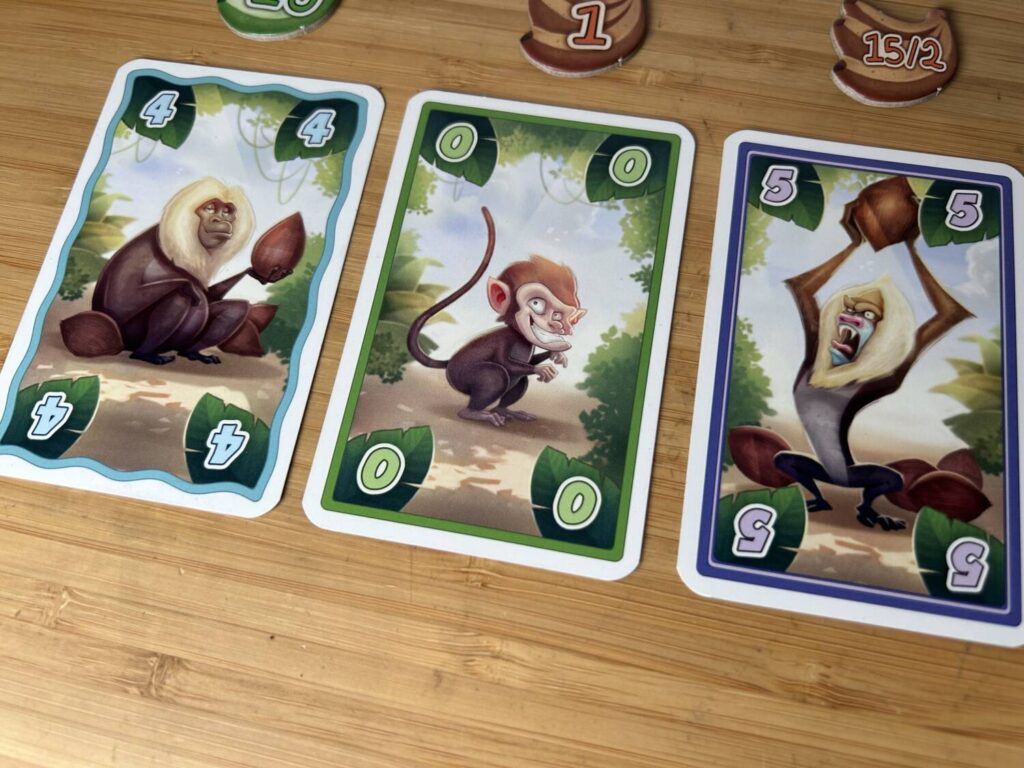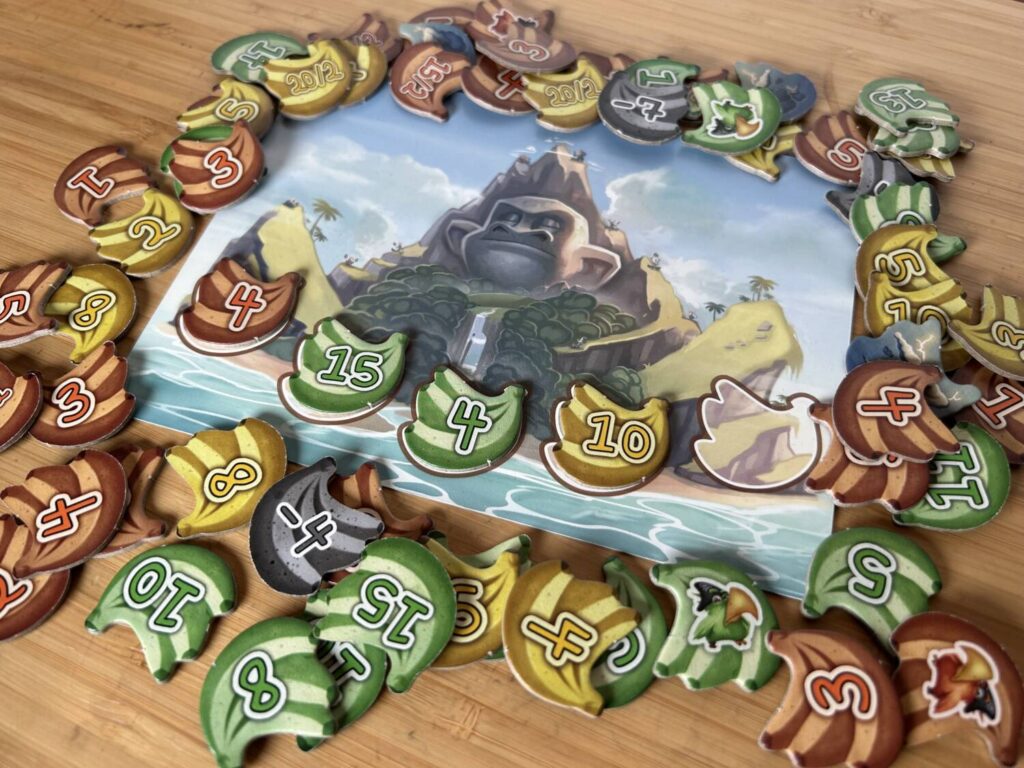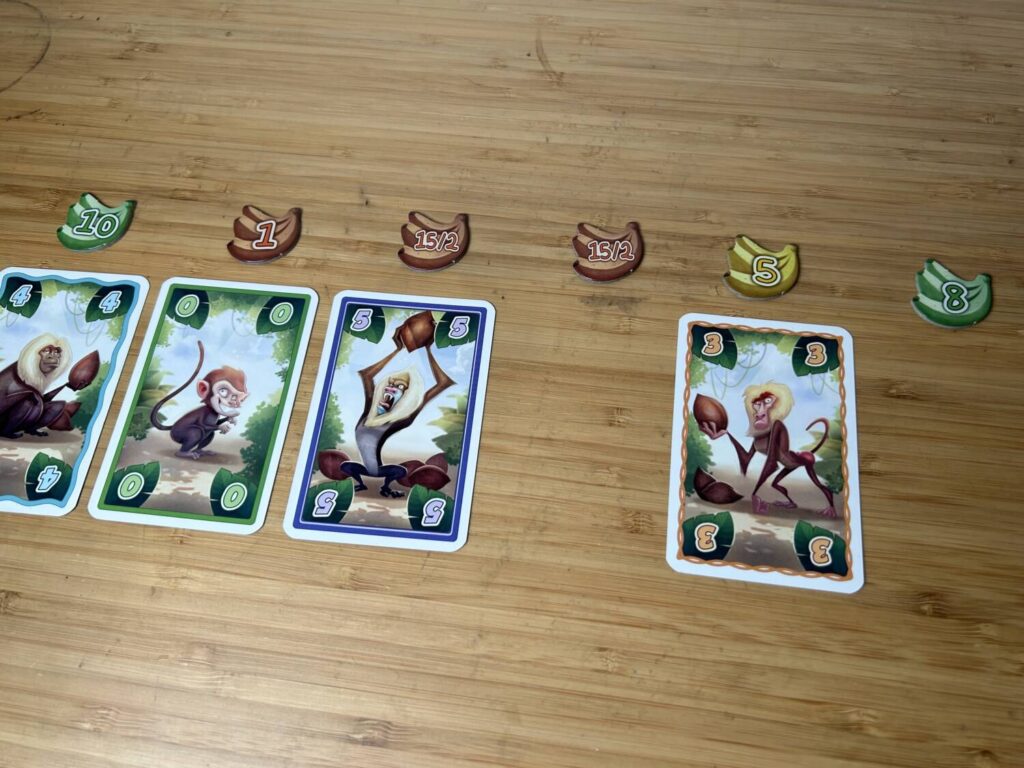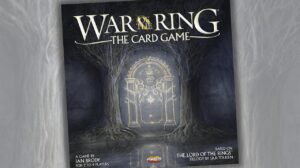Disclosure: Meeple Mountain received a free copy of this product in exchange for an honest, unbiased review. This review is not intended to be an endorsement.
In 1984, a team of primatologists went out in search of a legendary ape civilization, thought to exist on an island in the tropics. What they discovered fundamentally altered our understanding of our simian relatives.
The apes were rumored to have advanced arts and architecture. This turned out to be an understatement. The island was volcanic, and the impressive mountain face at its center had been carved by the apes to resemble an ape-ian Mount Rushmore. There was a full system of currency, based around coconuts. What’s more, the apes engaged collectively in a fascinating ritual. Come harvest time, the bananas would be divided amongst the family groups via an elaborate auction.
One of the members of that expedition was a young PhD candidate by the name of Reiner Knizia, who, nearly fifty years later, has paired up with publisher Zoch Verlag to present Reif für die Insel. At last, the larger public can access the notes taken during one of the most important zoological studies of the 20th century.
Is any of that true? Probably not. On the other hand, Reiner Knizia is a doctor, and you probably don’t know what his doctorate is in, so. Who’s to say?
Gorilla Warfare
In Reif für die Insel (Ripe for the Island), every player gets two things: an identical hand of cards, numbered 0-7 and 10, together with an island board, which has five slots for banana tokens. Each round, the starting player—my group took to referring to them as the Top Banana, since the starting player card is, well, a banana—draws one bunch of bananas per player and lays them out in a row. Once that’s done, the auction can begin.
The starting player then puts down a card under the bunch of their choice. This is an important decision, since the value of the card you play is your bid. That token will be yours come the end of the round, provided your card is still there. Any subsequent player can give you the boot by playing a higher card onto the same bunch. If that happens, the usurped player immediately gets their card back. Play continues around the circle, skipping any and all players who have a card out, until every player has something on the table.
At that point, each player takes their token and places it in one of the slots on their board. All cards higher than a 0 are removed for the rest of the game, while 0’s are returned to their owners. This process repeats until all player boards are full. At that point, you start the Feeding Phase.
Every banana token is a color, be it green, yellow, brown, or black (ew). You bid on each like any other, but those colors aren’t just for show. During the Feeding Phase, the apes are only interested in ripe bananas. During the first Feeding Phase, they eat up all your brown and black bananas. During the second, they’ll also take any yellow bananas you happen to have lying around. Come the third, which ends the game, they eat everything.
You want the apes to eat your bananas. That’s how you score. Eaten bananas move to the top of your player board, freeing up slots for the next round. Any bananas that don’t get eaten continue to hold their slot on your board, which means you have less space for bananas in the future.
This isn’t as debilitating or punitive as it may seem. If your board is full, you still participate in auctions, and in point of fact you have more freedom than players with empty slots. If your board is full, you can choose whether or not you want to keep the bunches you win, swapping them out for another on your board. In rounds with black bananas, which are worth negative points, that’s a powerful choice to have.
Auction Appeal
My friend Douglas and I were recently discussing auction games over a heated match of Medici v. Strozzi, another Knizia auction game from way back. I love that game, I think it’s a fascinating design, but for me the shine wears off a bit when playing against people who do math. Auction games come in two flavors, broadly speaking: there are those where the value of everything is obvious and calculable, and there are those where the value is inscrutable.
Medici v. Strozzi is a good example of an auction game where everything is more or less calculable, like Chinatown or Modern Art. Douglas and I share a preference for auction games like Ra, where the values are a bit more opaque. There’s nothing quite like going all-in on a lot with nothing but vibes to guide you.
In Reif für die Insel, ripening gives all of the tokens less of a known value. I could dedicate myself to winning a high-value green token in the first round, but then that token is going to sit on my board for the rest of the game, holding a spot that could go to something else. Maybe it’s better to get a low-value brown token, which will clear out right away. It’s impossible to say. Both can be right.
I love the tension of not getting your cards back, too. That introduces extra stakes to each auction. Are you willing to pay 7 for a token when you know that you’re giving up your 7 for the rest of the game? Is it worth ceding that future advantage for whatever you’re bidding on right now? Furthermore, you also have to ask yourself if it’s better to let your opponent take the token and lose the card they’ve bid. I could kick Keren’s 6 card off of that 12 point banana, but it could be to my long-term advantage to let her take it and lose the 6. Again, it’s impossible to say for sure.

Ook
Reif für die Insel is a charming, approachable auction game. It borrows more from Ra than I was expecting, but I can teach it to you in about a third of the time. The auctions move quickly, the decisions are pleasantly tense, and there’s ample space for tactical play.
In my opinion, the game is best at higher player counts. I vastly preferred my games with 5 or 6 players to my games with 3 or 4. Most Knizia designs become increasingly random as you raise the player count, but Reif für die Insel is a rare exception. More players means more tokens drawn from the bag, which means you can more easily plan and make long-term choices. Waiting for a big token to drop isn’t such a good idea when it’s entirely possible that no big tokens will make an appearance, and a lone negative point black banana can decide the whole game.
I haven’t even mentioned the parrots and the lightning clouds, the two other types of tokens you can draw from the bag. Parrots come paired with a banana bunch during the auction, and abscond with one of your bunches come the Feeding Phase. Lightning clouds change the auction format for one round into simultaneous reveal, a fun and easy way to shake things up.
Simple enough for children to play—the 8+ listed on the box is conservative—but rich enough for adults to enjoy, Reif für die Insel is another rock-solid entry in Reiner Knizia’s formidable roster of auction designs. I like it a lot more than I anticipated. I don’t quite love it, probably because Ra exists and I would much rather play Ra, but I’ll be keeping it in my collection for the time being.
What can I say? I like Reif für die Insel a whole bunch.













Add Comment